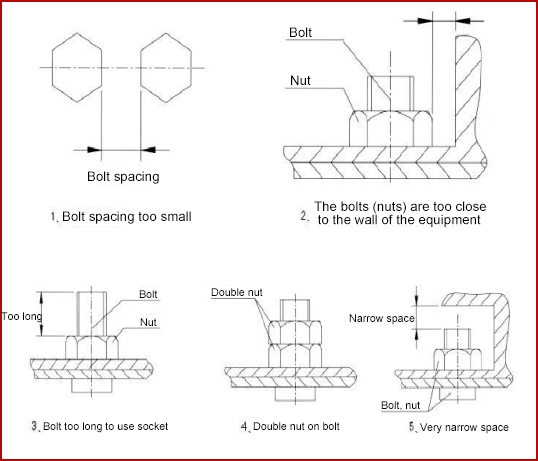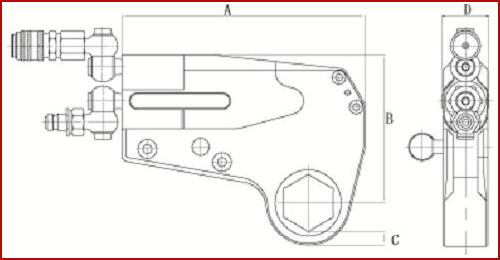What Size Hydraulic Torque Wrench Do I Need?
Many customers do not know what size hydraulic wrench should be used for the working conditions of the project, and how to determine the size of the hydraulic wrench. Now, Torcstark will go into detail on the question of what size hydraulic torque wrench should I use. Hopefully, through this tutorial, our users can easily determine the size of the hydraulic wrench they need.
Determining what size hydraulic wrench to use is a total of three steps. For the construction, maintenance and emergency repair of hydraulic wrenches in wind power manufacturing and installation, ship engineering, petrochemical, construction, electric power, mining, metallurgy and other industries, various and complex applications, each situation will affect the choice of the hydraulic wrench. Therefore, when choosing a hydraulic wrench, the following three steps are necessary.
Determine the size of bolts and nuts
First confirm the size of the required bolt, the size of the opposite side of the nut and the strength grade of the bolt. The bolt and nut specifications are 1, 2, 3, or large-size models, and the sleeve size can be determined according to the hexagonal specification and model range of the nut.
Determine the torque value required for bolt tightening
The torque size of the hydraulic wrench is the main parameter for selecting the wrench. According to the different torque sizes, it can be divided into various specifications and models. The torque of the bolt is different, the torque of the same bolt material is different, the torque of the same material is different under different working conditions, and the bolt torque is different for rolling mill machinery and chemical machinery equipment. You can choose according to the ready-made torque value and space size. The torque required for the tightening of the bolts on the general equipment is provided by the equipment manufacturer. If there is no torque value, it can also be calculated and selected according to the bolt specification and strength grade, referring to the recommended value in the “Bolt Specification and Torque Comparison Table”. Also, refer to the following tabular data:
| Strength Grade | 4.8 | 6.8 | 8.8 | 10.9 | 12.9 | ||||||
| Minimum breaking strength | 392MPa | 588 MPa | 784 MPa | 941 MPa | 1176 MPa | ||||||
| Materials | General structural steel | Mechanical structural steel | Chrome molybdenum alloy steel | Nickel-chromium-molybdenum alloy steel | Nickel-chromium-molybdenum alloy steel | ||||||
| BoltM (mm) | NutS (mm) | Torque | Torque | Torque | Torque | Torque | |||||
| (KGM) | (NM) | (KGM) | (NM) | (KGM) | (NM) | (KGM) | (NM) | (KGM) | (NM) | ||
| 14 | 22 | 7 | 69 | 10 | 98 | 14 | 137 | 17 | 165 | 23 | 225 |
| 16 | 24 | 10 | 98 | 14 | 137 | 21 | 206 | 25 | 247 | 36 | 353 |
| 18 | 27 | 14 | 137 | 21 | 206 | 29 | 284 | 35 | 341 | 49 | 480 |
| 20 | 30 | 18 | 176 | 28 | 296 | 41 | 402 | 58 | 569 | 69 | 676 |
| 22 | 32 | 23 | 225 | 34 | 333 | 55 | 539 | 78 | 765 | 93 | 911 |
| 24 | 36 | 32 | 314 | 48 | 470 | 70 | 686 | 100 | 981 | 120 | 1176 |
| 27 | 41 | 45 | 441 | 65 | 637 | 105 | 1029 | 150 | 1472 | 180 | 1764 |
| 30 | 46 | 60 | 588 | 90 | 882 | 125 | 1225 | 200 | 1962 | 240 | 2352 |
| 33 | 50 | 75 | 735 | 115 | 1127 | 150 | 1470 | 210 | 2060 | 250 | 2450 |
| 36 | 55 | 100 | 980 | 150 | 1470 | 180 | 1764 | 250 | 2453 | 300 | 2940 |
| 39 | 60 | 120 | 1176 | 180 | 1764 | 220 | 2156 | 300 | 2943 | 370 | 3626 |
| 42 | 65 | 155 | 1519 | 240 | 2352 | 280 | 2744 | 390 | 3826 | 470 | 4606 |
| 45 | 70 | 180 | 1764 | 280 | 2744 | 320 | 3136 | 450 | 4415 | 550 | 5390 |
| 48 | 75 | 230 | 2254 | 350 | 3430 | 400 | 3920 | 570 | 5592 | 680 | 6664 |
| 52 | 80 | 280 | 2744 | 420 | 4116 | 480 | 4704 | 670 | 6573 | 850 | 8330 |
| 56 | 85 | 360 | 3528 | 530 | 5149 | 610 | 5978 | 860 | 8437 | 1050 | 10290 |
| 60 | 90 | 410 | 4018 | 610 | 5978 | 790 | 7742 | 1100 | 10791 | 1350 | 13230 |
| 64 | 95 | 510 | 4998 | 760 | 7448 | 900 | 8820 | ||||
| 68 | 100 | 580 | 5684 | 870 | 8526 | 1100 | 10780 | ||||
| 72 | 105 | 660 | 6468 | 1000 | 9800 | 1290 | 12642 | ||||
| 76 | 110 | 750 | 7350 | 1100 | 10780 | 1500 | 14700 | ||||
| 80 | 115 | 830 | 8134 | 1250 | 12250 | 1850 | 18130 | ||||
| 85 | 120 | 900 | 8820 | 1400 | 13720 | 2250 | 22050 | ||||
| 90 | 130 | 1080 | 10584 | 1650 | 16170 | 2500 | 24500 | ||||
| 100 | 145 | 1400 | 13720 | 2050 | 20090 | ||||||
| 110 | 155 | 1670 | 16366 | 2550 | 24990 | ||||||
| 120 | 175 | 2030 | 19894 | 3050 | 29890 | ||||||
Note:
1. The above is the German industrial standard. The torque value in the table is measured when the bolt reaches 70% of the yield limit.
2. The recommended tightening torque value is: the data in table × 80%. For example: M48, 8.8 grade bolt, the locking torque is: 400×80%=320KGM.
3. The loosening torque is 1.5~2 times the locking torque. For example: the tightening torque in the above example is 320KGM, then the loosening torque is about 320×(1.5~2)=480~640KGM.
After the bolt tightening torque is determined, select the corresponding hydraulic wrench. Generally, the tightening torque of the bolt does not exceed 70% of the selected hydraulic wrench. For example, if the bolt tightening torque is 6000NM, choose a hydraulic wrench with a maximum output torque of more than 8600NM, because the required torque is lower than 70% of the maximum torque value of the selected hydraulic wrench. However, if this torque needs to be loosened, you need to choose a hydraulic wrench with a maximum torque value greater than 9000NM.
Determine which type of hydraulic wrench to choose based on working conditions
Hydraulic wrenches are classified according to the power form: according to different power forms, they are divided into electric, pneumatic, etc. According to its appearance, it can be divided into drive and bell hollow. The specific choice should be based on the working environment of different industries.
For Example
The drive hydraulic wrench drives the sleeve to work through the rotation of the drive shaft. One type of wrench can work with multiple sleeves, which is relatively widely used. However, in some small spaces, there are also cases where the hydraulic wrench of the drive shaft cannot be put in to cause interference. At this time, a low-profile wrench is used. The low-profile hydraulic wrench is composed of a power head and a working head. Due to its flat structure and the feature of being used directly on the nut, it is suitable for narrower spaces. A low-profile hydraulic wrench may be required in the following situations:


Five situations in which a low-profile hydraulic wrench is required
Low-profile hydraulic wrenches also have limitations. For example, some user units want to use one working head to achieve nut work under various working conditions. At this time, they will choose a bushing to increase the scope of use. However, increasing the spacer will increase the thickness of the working head, that is, the C value in the following figure will become larger:


This way the hydraulic wrench cannot fit over the nut. Moreover, two adjacent nuts with bushings are easy to break when used because the bushings are too thin. Generally speaking, a working head can only add two bushings at most, and sometimes only one bushing can be added. For example: the working head of the opposite side 80 can turn 80 to 70, and 80 to 65. Therefore, when using a hollow hydraulic wrench to add a bushing, you must understand the data of the working conditions in detail.
In some working conditions such as flange surface connection, using two or four synchronizations to work at the same time greatly improves the work efficiency, and the flange surface is evenly stressed, and some chemical equipment is less likely to leak.
In the end
How to choose a suitable hydraulic wrench and improve the use effect of the hydraulic wrench is to choose different hydraulic wrenches according to the size of the user’s on-site working conditions. If you do not know the relevant data yourself, you can directly provide the working condition information to our sales manager, and we will recommend the most suitable hydraulic wrench for you.